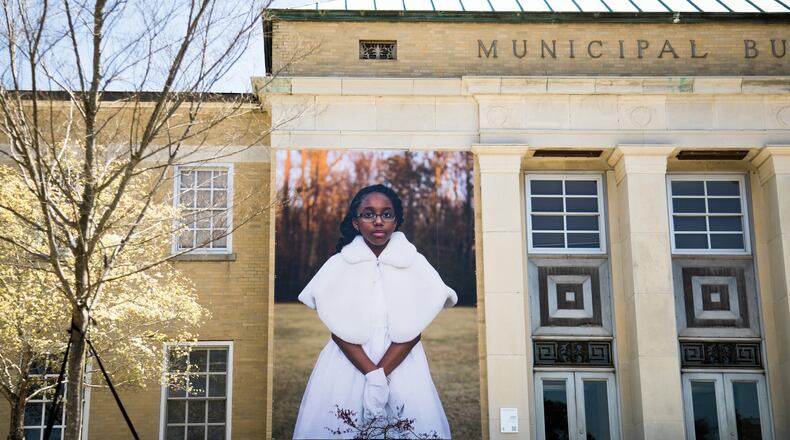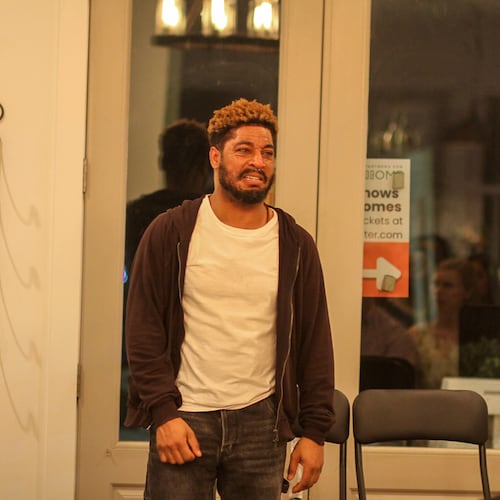Can a middle-aged white woman from Rhode Island help a Southern town contend with its troubled past?
It's a question the artist Mary Beth Meehan, 52, asked herself while working on the public art project "Seeing Newnan" for the town of 38,000 located 40 miles southwest of Atlanta.
Currently on view through June, the project features 17 enormous photo banners that hang from various buildings in Newnan’s historic downtown, including the Presbyterian Church, a toy store, the Wadsworth Auditorium and a fitness center.
The images are portraits that present a cross-section of people who live in Newnan — a domestic worker, a manual laborer, a millworker, high school students, pastors, children in their cotillion finery, an Ivy Leaguer — in a kind of alternative advertisement of place. In addition, Meehan posted interviews with her subjects on her blog at www.marybethmeehan.com. Black, white, well-to-do and on-the-margins — all are put on an equal footing. Meehan's billboard-sized photos suggest a kind of Norman Rockwell street art, treating ordinary people as monumental in keeping with an American democratic ideal.
Her project is part of Newnan ArtRez, an artist-in-residency program that provides a retreat for artists who, in turn, enrich the community with their work. It is sponsored by the University of West Georgia and funded by charitable trusts.
Soon after arriving in Newnan in 2016 and speaking to its residents, Meehan knew her project was going to have to grapple with race. How could it not be? Even though Newnan had a growing population of immigrants and newcomers drawn by the town’s affordability and its proximity to Atlanta and Hartsfield-Jackson Atlanta International Airport, the town’s past still haunted some black residents. Historically, Newnan made its fortune from a cotton industry fueled by slavery, like much of the South. And it was the site in 1899 of one of the most notorious lynchings in Southern history of victim Sam Hose.
Even today, Newnan remains geographically divided by race. Yet, “there are still people who think race is not an issue,” says Andrew Copeland, 26, the youngest and only black board member for Newnan ArtRez.
More than half of Meehan’s banner subjects are non-white in a town where 62 percent of the population is white. More importantly, they are economically and socially diverse. They represent a broad spectrum of black life in a nation where such complex portraits are still relatively rare.
Meehan knew when she started the project that a northerner treating race in the South was a tinderbox.
“It wasn’t easy for any of us. There were people who were going, ‘Why is she writing about white supremacy? Get her out of here,’” admits Meehan, whose photography has appeared in the New York Times, the Boston Globe and Le Monde. Her previous photo projects have addressed issues such as income inequality in Silicon Valley and immigration in Providence, Rhode Island.
The Newnan project almost didn’t happen. Business owners worried it would stir up controversy. Even members of the Newnan ArtRez board had reservations. “Why are you doing this?” Meehan was asked about her motives. “We had some really rough conversations. There were tears,” admits board member Liza Nelson Brown. One mural had to be moved to another location when the original sponsor backed out.
“Seeing Newnan” debuted in the spring of 2019, and Newnan ArtRez board president Robert Hancock says the response on social media was immediate. “I was so overwhelmed and disarmed by it,” he says. He wondered, “is this the town I live in?”
Some residents complained on Facebook about a portrait of teenage sisters Aatika and Zahraw Shah wearing hijabs that hangs on an office building. That photo fueled anti-Muslim invective and generated a story in The New York Times.
“The nastiness of the posts,” says Meehan. “It made me think, this is what it must have been like for people of color one generation ago.”
“Take down the Muslim picture or someone else will,” one commenter wrote.
But Hancock says the rebuttals to those comments were also instantaneous, with people calling out their neighbors for racist and Islamophobic comments.
“There are these dissenting voices,” says ArtRez board member Susan Crutchfield. “But the majority of people are so positive.”
Despite the negative attention, Aatika is glad she participated in the project, which she likened to Brandon Stanton’s “Humans of New York” project that features street photography of ordinary people who share their personal stories. “I love Georgia,” she says. “Seeing those faces around Newnan, it opened up a lot of conversations. (It) opened up Newnan through a new lens and (created) an understanding of the diversity of Newnan, in religion, in race.”
Monique Bentley, a 23-year-old senior at Georgia State University, was photographed in Newnan’s Farmer Street cemetery adjacent to the African American Heritage Museum, where enslaved people are buried.
“(Race) can be a scary topic to talk about,” Bentley says. “The white community doesn’t want to accept what their ancestors did to our ancestors. (But) what we do moving forward is what matters, even if it means uncovering the dark history.”
Meehan says it is hard to deny the injustices of the past in the stories she heard from people like domestic worker Helen Berry, resplendent in a tangerine-colored caftan in Meehan’s portrait. Berry grew up in Newnan under segregation and found limited prospects available to her.
“The fact that Mrs. Berry graduates from high school in 1954 and is consigned to a professional life that is way below her intellectual, human abilities because of racially inscribed laws,” posits Meehan, “how could that not have had an effect on how people are relating to each other in 2020?”
The murals have prompted many residents to contemplate disturbing events like Hose’s lynching and the neo-Nazi rally held in 2018 in Newnan’s Greenville Street Park, where the local counter-protesters far outnumbered the white supremacists, who were outsiders to the community.
“It’s not where it was 50 years ago,” says Copeland, of Newnan. “But we’re not where we need to be today. And I think that this project is inherently good because it can spark these conversations.”
Newnan still feels like a place where black and white residents live in separate worlds. The charming downtown area is home to both Meehan’s regal portrait of a black pastor, Rev. Rufus Smith Sr., and a monument to Confederate dead.
For longtime Newnan resident Tavaris Johnson, a student at Georgia College & State University in Milledgeville, “Seeing Newnan” provided a way to look at his community in a new light.
“My race has shaped my life’s experiences, and some people are unwilling to acknowledge that,” says Johnson, who credits Meehan’s outsider status for bringing a fresh perspective to the topic. “I think it’s important for people to be exposed to the people they normally have no, or limited, contact with. That’s why I was drawn to this project.”
In the end, “Seeing Newnan” is evidence of public art’s potential to prompt a community to look deeper at itself and examine what lies beneath the surface of perceived realities.
When so many Americans seem unwilling to grapple with the issue of racism, at least Meehan is trying, and so is Newnan.
ART EVENT
'Seeing Newnan.' Through June. Various locations, downtown Newnan. Free. www.westga.edu.
About the Author
Keep Reading
The Latest
Featured






